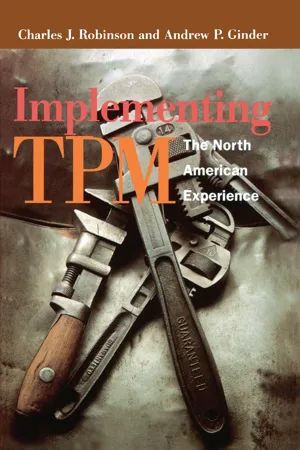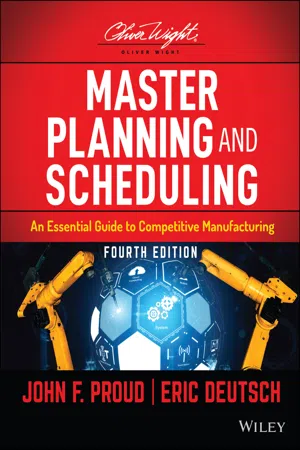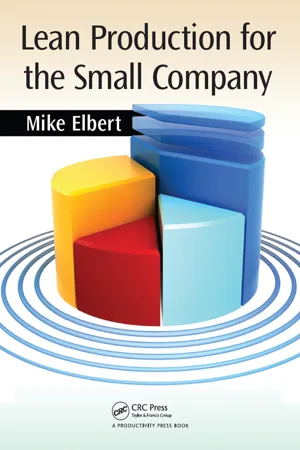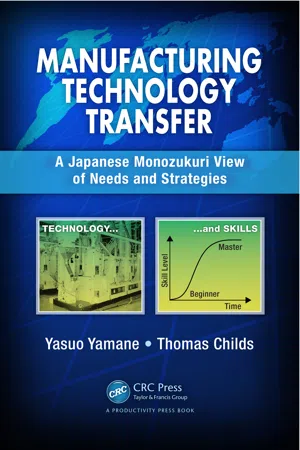Flow Production
Flow production is a manufacturing method where products move continuously through a production process without interruptions. It aims to minimize waste and maximize efficiency by organizing tasks in a sequential and streamlined manner. This approach often involves the use of assembly lines and just-in-time inventory systems to ensure a smooth and continuous flow of production.
5 Key excerpts on "Flow Production"
- eBook - ePub
Implementing TPM
The North American Experience
- Andrew Ginder, Alan Robinson, Charles J. Robinson(Authors)
- 2020(Publication Date)
- Productivity Press(Publisher)
...Goldratt Institute) and published an additional book, The Race, 9 further promoting the strategy as the solution for optimizing manufacturing operations. Continuous flow manufacturing can best be defined as a manufacturing philosophy which strives to continually reduce manufacturing inefficiencies through improvements in logistics. This can be complementary to TPM’s focus on equipment related losses. CFM is a common sense approach that concentrates on turning raw materials into finished products as quickly as possible and with no wasted effort. Also, the production philosophy is time-based and optimizes the material flow and logistics of the whole organization as opposed to productivity on individual segments of the production process. Continuous flow manufacturing principles promote focus on improving production process bottlenecks or constraining operations to the exclusion of all other improvement efforts. The goal is to increase throughput while simultaneously decreasing inventories and true operating expenses. Continuous flow manufacturing starts with the basic premise that the goal of any plant organization is to make money now and in the future. An efficient plant that is not profitable does not provide value, and should be examined for potential elimination or sale. Making money is defined in terms of net profit and return on investment. Definitions of terms which are used in continuous flow manufacturing are as follows: • Throughput. The rate at which any organization generates cash through sales of product, services, or assets. This is equal to sales minus variable expenses. • Investment. Money that an organization spends on things that can ultimately be turned into cash...
- eBook - ePub
Master Planning and Scheduling
An Essential Guide to Competitive Manufacturing
- John F. Proud, Eric Deutsch(Authors)
- 2021(Publication Date)
- Wiley(Publisher)
...There are no intermediate workstations, no production queues, and/or no handling equipment (intermediate workstations, production queues, and handling equipment don't add any value to the product; these nonoperative steps only add cost). And there are usually fewer people. Machinery and the movement of work‐in‐process are integrated into a generally seamless, continuous process. Together, these elements reduce manufacturing cost and the amount of time that work remains in the process. In the perfect process, raw materials are dumped into a hopper at one end of the line, and finished goods emerge from a pipe or packaging machine at the other (see Figure 7.2 on page 230). Figure 7.2 The Flow Manufacturing Environment Few operations, however, fit the ideal image just described. Many are still characterized by the processing of batches that must be queued from one step of the operation to the next. 1 This makes some manufacturing highly sensitive to the sequencing of work put into the line. For example, the planner and/or scheduler of salsa would probably want to run a batch of mild salsa through the series of vats and mixers before sending a batch of hot salsa through them. Doing the reverse would require that the equipment be flushed out between batches so that the mild salsa would not pick up any residual spicy ingredients. Many manufacturing processes, of course, operate in the vast middle ground between the two extremes just described. Some assembly operations, for example—particularly those characterized by moving assembly lines that do rapid, repetitive work—share many characteristics of the flow environment. Indeed, the history of manufacturing of all types of products has followed an evolution from a discrete set of separate operations to a continuous flow of work. In some cases, this has been accomplished by a simple reconfiguration of the manufacturing facility, in which machines are arranged to eliminate transfers, queues, and storage areas...
- eBook - ePub
Job Shop Lean
An Industrial Engineering Approach to Implementing Lean in High-Mix Low-Volume Production Systems
- Shahrukh A. Irani(Author)
- 2020(Publication Date)
- Productivity Press(Publisher)
...Quoting from his book “…the importance of factory layout has not been addressed in spite of the significant waste often associated with badly planned layouts…the impact on a company’s performance from improving the layout can be substantial… Flow refers to the movement of material through the plant. It assumes that material will not be stagnant at any point in time from the receiving of raw material to the shipping of finished products… Problems such as a process-oriented layout (Functional Layout), line imbalance, machine breakdowns, long setup or tool-change time, machine breakdown, quality problems, and labor absenteeism cause interruptions that disrupt a steady flow of production in a factory…”. Any HMLV manufacturer seeking to implement Job Shop Lean should invest in designing, and changing as necessary, their factory layout in order to achieve Flow. Appropriately, all constraints that hinder Flow help to determine Continuous Improvement (CI) projects to improve factory operations using other TPS/Lean tools such as Error Proofing, Quality At Source, Total Productive Maintenance, Workforce Engagement, and Setup Reduction. This approach is in stark contrast to the conventional wisdom of undertaking a large portfolio of kaizens 3 to eliminate the Seven Types of Waste (see Figure 4.8)...
- eBook - ePub
- Mike Elbert(Author)
- 2018(Publication Date)
- Productivity Press(Publisher)
...Chapter 8 Continuous Flow Introduction Now we need to create continuous flow on the production floor. Many people believe they already have continuous flow but is it continuous without stopping or is there stored inventory between processes? We will create flow based on Lean principles in this chapter. Many companies have what is known as process village layouts ; a different way to say this is similar machines and processes are grouped together, such as all machining centers together, all lathes together, all sheet metal brakes together, etc. This method of factory layout is very common. In this type of layout, the product does not really “continuously flow”; it starts and stops as it moves through the different processes, being held up many times, as we found out in our value stream map. As a result, it is difficult to respond quickly to ever-changing customer demands even if you maintain large amounts of WIP (work-in-process) inventory. Step 1: Determine Family Mix Determine what your product family mix is. This you do by creating a matrix of products and processes; Figure 8.1 shows you how to construct the matrix. I like to add a column for percentage of company sales. This allows you to decide which area you would like to focus on first. By looking at the matrix, you also get an idea of where you may want to place the pacemaker cell for those products. In this case, some products could have a pacemaker at test, while others have it at subassembly. Figure 8.1 Product Family Matrix. Before you begin to rebuild your product line for continuous flow, make sure you have enough capacity to sustain production for your other customers. Step 2: Build First Production Cell Start by building your first production work cell. You want to keep the cell simple; this will support another principle of Lean manufacturing, which is to minimize capital expenditure...
- eBook - ePub
Manufacturing Technology Transfer
A Japanese Monozukuri View of Needs and Strategies
- Yasuo Yamane, Tom Childs(Authors)
- 2018(Publication Date)
- Productivity Press(Publisher)
...They are jobbing (or job shop) production, suitable for products with a large variety and small numbers of each product; lot (or batch) production, for smaller variety but larger numbers; and line production, with least variety and largest numbers of products. In the case of jobbing production, the repeat demand for any particular product is small. A general purpose production facility is prepared. Machine tools are laid out in the factory to respond equally to the demands of any product. At the opposite extreme, in line production, a production facility is arranged as a linear series of stations for the exclusive continuous production of one product. In between, lot production fulfills the need for medium variety and volume demands. Machines are organized as a number of general purpose facilities, each of which can be used for a special purpose by changing setups. This organization increases productivity. In the case of job shop production, products are made individually to a customer’s specification. The management question is how to produce the orders quickly and efficiently. By contrast, for continuous line production the question is how to respond economically to varying demand for a product while at the same time keeping the production line running. For lot production, it is expected that different products will be manufactured at different times. Effective management is concerned with what is the best way to respond to changing customer orders. Questions to answer are what is the required lot size and how to inject new orders into the manufacturing schedule. It leads to promoting commonality and standardization of parts between products that are made in lot quantities. FIGURE 5.3 Process structures based on demand variety and demand volume. 5.2 THE PRODUCT LIFE CYCLE The range of management technologies and production systems is described in the last section...




